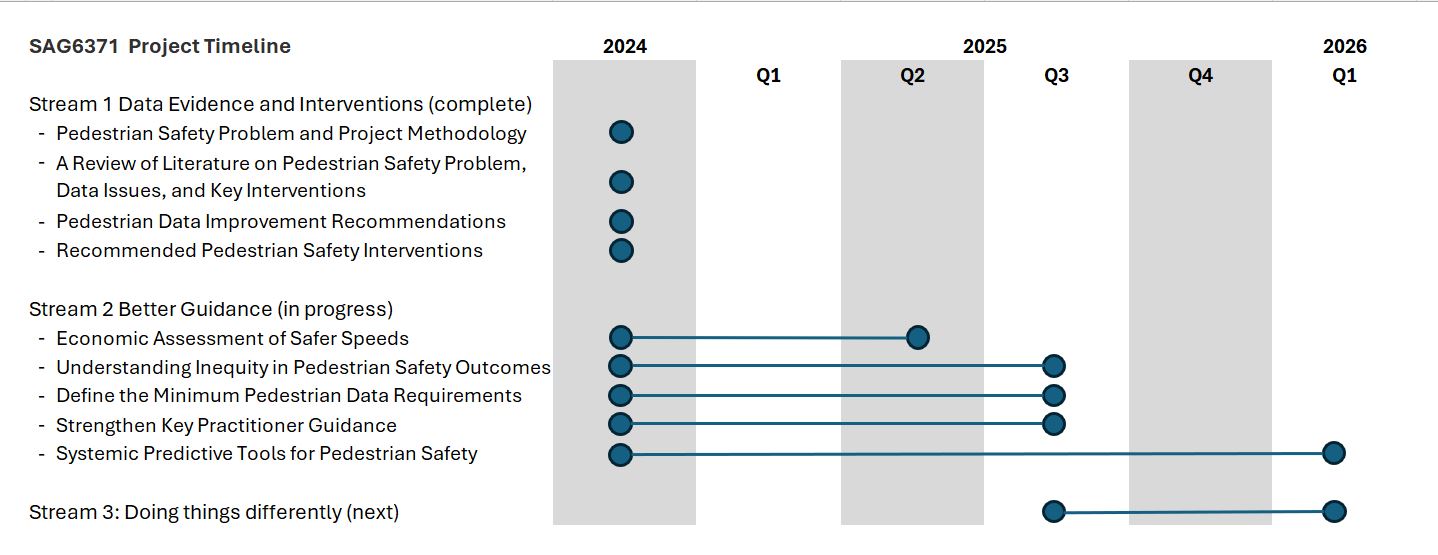Walking is the essential foundation of a sustainable transport system—yet pedestrians remain among the most vulnerable road users. Keeping People Safe When Walking is a comprehensive Austroads project aimed at significantly reducing pedestrian risk across the road transport system over the next decade.
This initiative is part of Austroads' Road Safety and Design Program, and is focused on delivering practical, evidence-based interventions to improve pedestrian safety.
Project’s vision
The Keeping People Safe When Walking project envisions a road and street network that places pedestrian safety at its core—regardless of age, race, gender, socioeconomic background, or physical ability. The project supports both national and local efforts to achieve Vision Zero targets: a 50% reduction in pedestrian fatalities and serious injuries by 2030, and their complete elimination by 2050.
To realise this vision, the project draws on data-driven insights to better understand pedestrian trauma and inform impactful interventions across the Safe System.
Key objectives
The project will:
- Review travel and trauma data to better understand and prioritise key pedestrian safety risks.
- Identify gaps and priorities in data collection to support informed investment in pedestrian safety.
- Assess strategies and interventions aligned with Vision Zero targets.
- Strengthen practitioner guidance to support consistent and effective implementation of safety measures.
- Support jurisdictions in planning and delivering initiatives to eliminate pedestrian deaths and serious injuries.
Project timeline
We have now concluded the project's Stream 1 "Data, Evidence and Interventions".
Several themes have emerged from Stream 1, providing evidence that implementing known interventions could reduce pedestrian fatalities and serious injuries in Australia and New Zealand by 70-90 per cent.
Stream 1 outputs are included in the four research reports listed below:
- Pedestrian Safety Problem and Project Methodology—Introduces the Pedestrian Safe System Model and Pedestrian Safety Data Needs Framework, articulating the current state of pedestrian safety and outlining core concepts to support consistent system-level planning and evaluation.
- Literature Review—Synthesises international evidence on effective interventions, identifies local barriers, and highlights the economic burden of pedestrian trauma. It also outlines data gaps, strategic blockers, and systemic weaknesses impeding progress.
- Pedestrian Data Improvement Recommendations—Provides practical recommendations to improve pedestrian exposure data, link crash and hospital datasets, and develop robust safety performance indicators—foundational to better prioritisation and intervention design.
- Recommended Pedestrian Safety Interventions—Sets out a suite of 54 actionable interventions, backed by in-depth trauma and Vision Zero modelling. Emphasis is placed on integration across infrastructure, speed and vehicle technology, supported by governance and community engagement.
Stream 2 builds on the work of Stream 1 to focus on areas of greatest value to Austroads members in delivering pedestrian safety outcomes. It will strengthen guidance and include an assessment of current practice by Austroads members, a gap analysis against best practice, and showcase examples of best practice from Australia and New Zealand.
Stream 2 will be progressed through the five work packages listed below:
- Define the Minimum Pedestrian Data Requirements
This work package aims to create a guide that outlines the essential data needed to support the development of policies and strategies to reduce pedestrian fatalities and injuries. It will identify data gaps and provide recommendations for addressing them using best practices. - Systemic Predictive Tools for Pedestrian Safety
This work package focuses on developing methods and prototyping a tool for estimating pedestrian crash risk and exposure and calculating pedestrian safety performance indicators for reporting and monitoring. - Economic Assessment of Safer Speeds
This project will evaluate the economic impacts of implementing safer speed limits in urban areas, considering effects on pedestrian safety, road trauma, community health, and mobility. The findings will guide decisions on appropriate road typologies for safer speeds. - Strengthen Key Practitioner Guidance
This initiative will identify ways that existing national practitioner guidance can be strengthened to improve pedestrian safety, incorporating recent developments and best practices from Australia and New Zealand. - Understanding Inequity in Pedestrian Safety Outcomes
This project will explore disparities in pedestrian safety outcomes, analyse trends, and provide recommendations to address inequities. It will include case studies, priority data gaps, and snapshots for key at-risk demographics.
Stream 3 will bring together leaders and practitioners to create a blueprint for eliminating pedestrian deaths and serious injuries by 2050.


